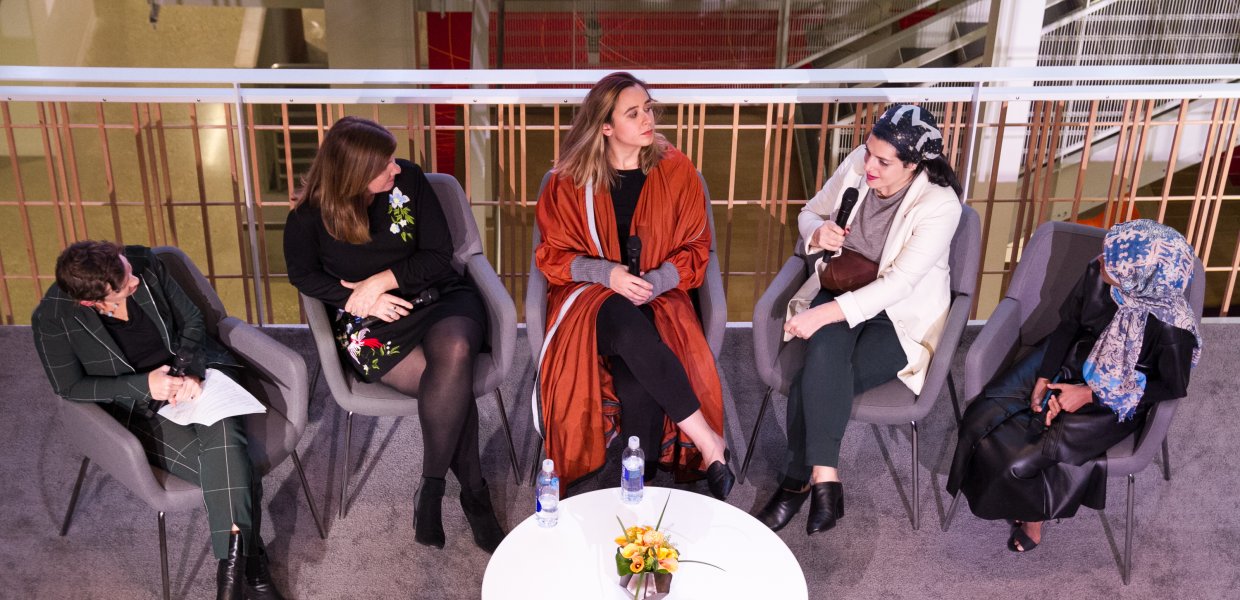There are thousands of panel discussions held on college campuses each year, and most have a well-worn look and feel: chairs arranged on stage, occupied by academics. But when Alison Trope, USC Annenberg clinical professor of communication and director of undergraduate studies, was given the opportunity to curate a series of events on fashion, she began by turning the topic inside out, re-imagining the very presentation of scholarly thought.
At an event last April called “Fashion + Social + Media: Influencers in the age of Instagram,” Trope gathered scholars and fashion influencers from around the country and reimagined Wallis Annenberg Hall as an interactive gallery. There was a retro 1960s living room in the lobby displaying vintage fashion magazines and screens with fashion videos. A graffiti artist drew street style art on the fly, while the ramp between the first and second floors became a zebra-striped catwalk. Life-sized paper doll cutouts of iconic outfits — a zoot suit, a Mondrian dress, a 1947 Dior New Look jacket and skirt — were set up for participants to pose behind and then post on Instagram.
The goal wasn’t the spectacle of the exhibits, or simply presenting information in a unique way. It was to demonstrate how social media is only the latest in a long history of seeing and communicating fashion. Trope said she was hoping to get participants “to think about the way in which fashion is really part of our everyday lives, the way in which it’s part of media and communication and all of these different sites that we experience every day.”
The impetus for the series was a grant from Gabriela and Austin Hearst, who also have funded scholarships for USC Annenberg graduate students studying fashion communication topics. Austin’s daughter graduated with a USC Annenberg communication degree in 2017, and Gabriela is a fashion designer known for luxury ready-to-wear and accessories. The Hearsts didn’t have a particular agenda or issue they wanted to promote. Rather, they wanted to bring insights from journalism and communication to the creative industry of fashion as it relates to media culture.
The gift allowed USC Annenberg to deeply investigate one industry and view it from multiple perspectives. “Fashion has so many layers to it and so many ways to understand and see it,” Trope said. “We wanted to bring academics and practitioners together as part of the larger discussion of how fashion is communicated.”

“So when we’re looking at fashion,” Trope said, “we’re not just looking at the apparel or not just looking at the clothes, we’re also thinking about bodies and what kinds of bodies wear those clothes. We’re looking at gender. We’re looking at transgender, we’re looking at sexuality, we’re looking at class, we’re looking at race and ethnicity and all of these things are going to impact the way we further understand the way fashion gains meaning, and also the way it gains meaning in relation to an individual’s identity.”
The first event in the fall, “Rethinking the runway: Race in the fashion industry,” highlighted the need for the industry to pay more attention to groups that are invisible or visible only in particular ways on the runway. One of the panelists, Ebonee Davis, a model and activist, noted that a model appearing in a black-oriented publication such as Essence or Ebony can result in her being labeled “urban,” which can work against her being booked for couture runways or print publications featuring high fashion.
“It’s maddening,” said Julee Wilson, Essence magazine’s beauty and fashion director and a second panelist, who runs up against this issue frequently when she is booking models.
“It creates a disconnect between the black top models and black people in the world,” declared Davis. “We’re pulling them from their roots in black culture.”
The second event in early November, “Ethical, sustainable and slow: Changing fashion’s priorities,” focused on the fashion industry’s environmental footprint.
“There is so much going on,” said panelist Marci Zaroff, an eco-fashion pioneer who has been working on global organic textile standards and fair-trade issues for nearly 30 years. “If you are in the textile industry and not in this, you are behind the game.”
Nyree Corby, whose fashion label Fame and Partners creates sustainably produced garments made to order for each customer. Her concept is simple: With no mass production, there’s less textile waste. “We can’t afford not to buy quality,” she told the audience.

The final event, “Fashion activism: Rethinking what we wear and what it means,” looked at the wide range of ways individual people wear particular garments to reflect their politics.
“We were really interested,” Trope said “in looking at the way in which one might wear a protest t-shirt or a pussy hat or a particular garment that suggests a kind of politics. But we were also interested in looking at the way in which wearing a particular garment like a hijab might be something that suggests religious freedom, political freedom.”
For Trope, these events not only further amplify her decade-long commitment to teaching fashion, media and culture, but also uniquely position USC Annenberg at the center of leading discussions on this critical topic forward.
“I am proud that USC Annenberg is really spearheading these conversations,” Trope said. “And we are spearheading them in ways that are not only intellectually important, but also raising issues of diversity, of sustainability, of activism that really bring the conversation to another level.”
To see videos of all of the events, please click this link.
